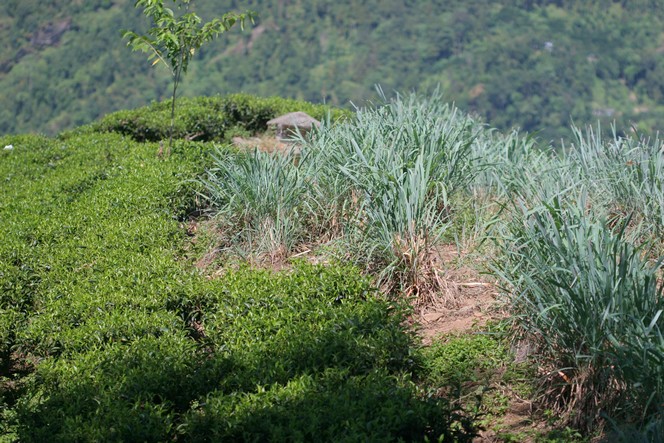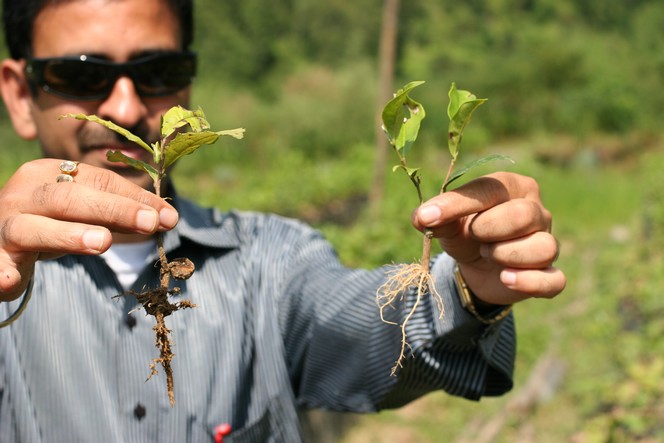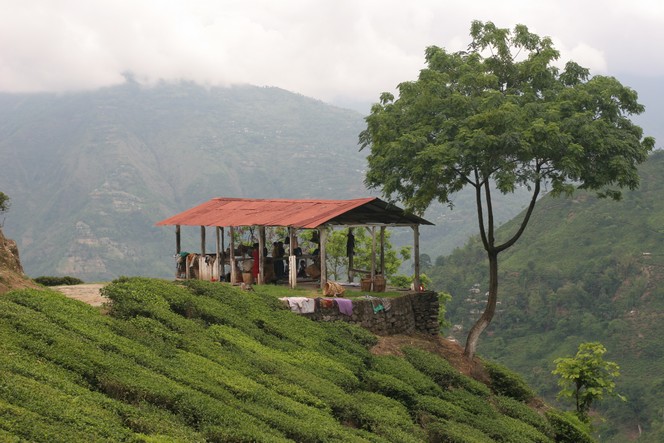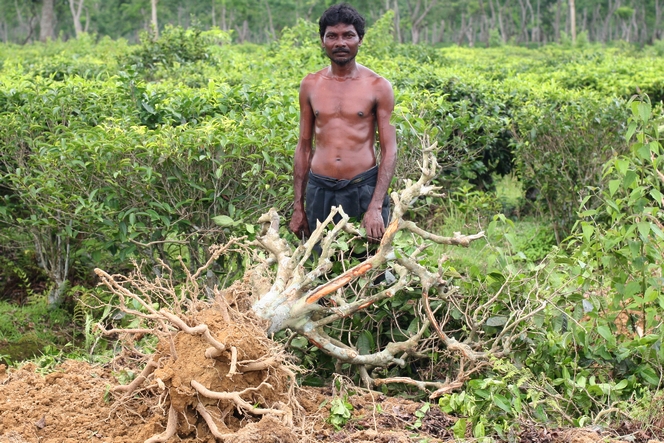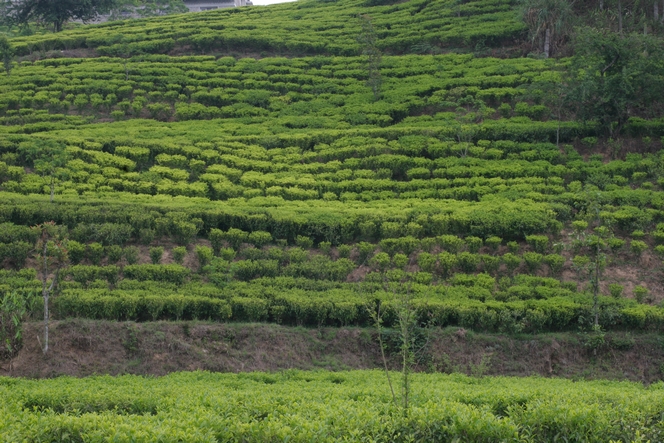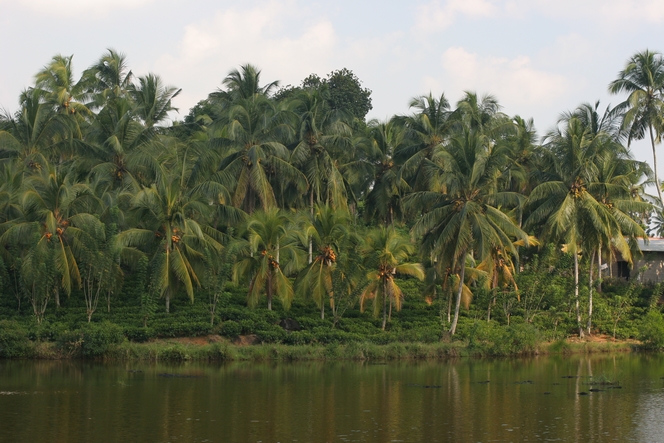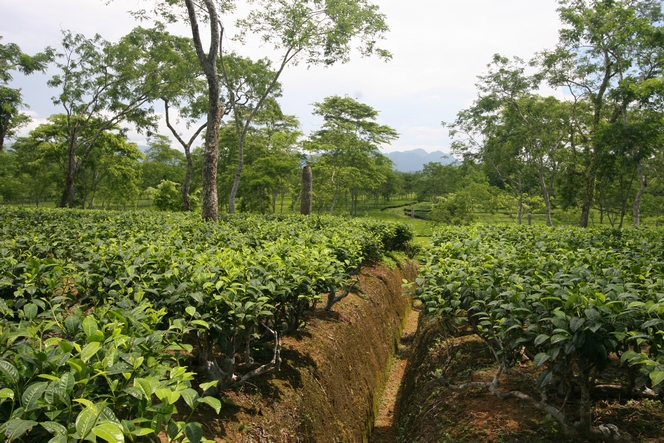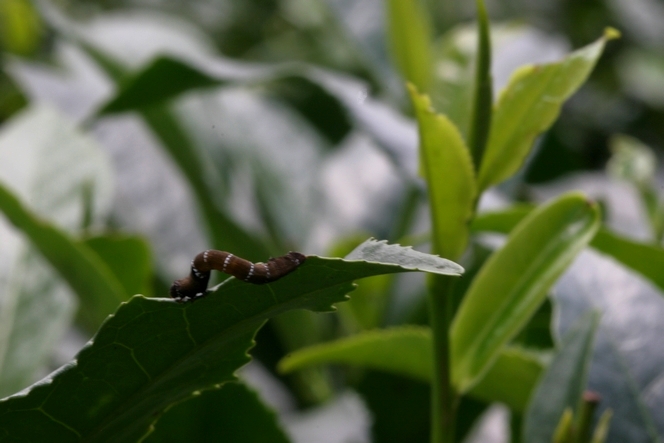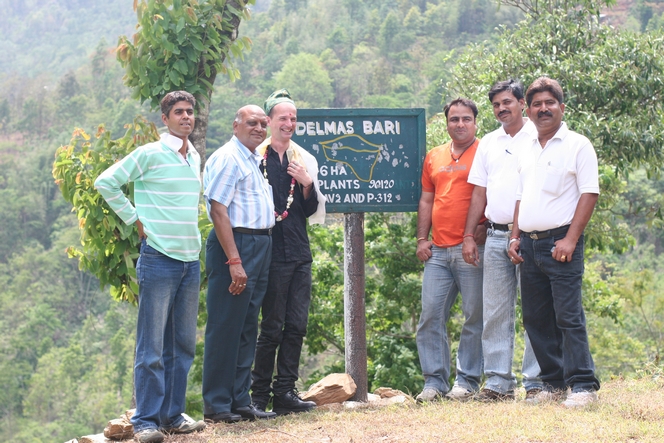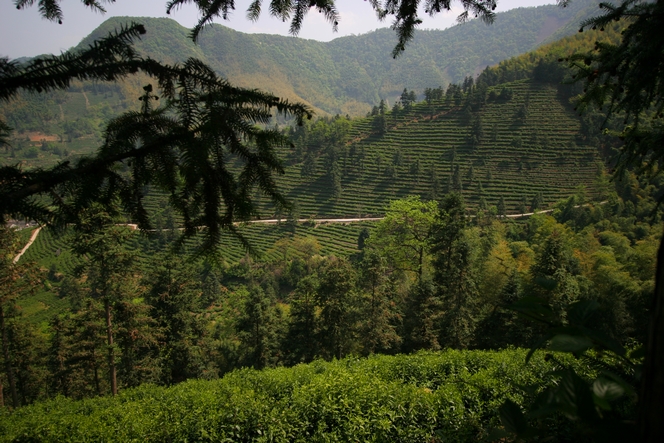In some plantations where organic or sustainable farming methods are used, you will see citronella plants growing among the tea bushes or along the edges of paths. There are several advantages to the citronella’s presence, particularly its ability to repel many insects that would damage the precious tea leaves.
Plantation
There are two ways of growing a new tea plant
There are two ways of growing a new tea plant. You can plant a seed, or a cutting.
Here, Rajiv Gupta, grower at the Tumsong Tea Estate, explains how the roots of a tea plant grown from seed (on the left) reach deep into the ground, while the roots of a tea plant grown from a cutting (on the right) spread out and don’t go very deep. This has important consequences in terms of how the plant withstands bad weather, dryness and soil erosion.
This shelter is where the pluckers gather
When it is time to take a break, the pluckers in Darjeeling gather in the shade to drink tea or eat their meals. We would all love to be able to have lunch every day in such a peaceful setting…
These shelters are also where the pluckers take the leaves to be collected and weighed. Once gathered together, the leaves are loaded onto a trailer and a tractor promptly tows them away to the factory for processing.
Théier arraché sous une chaleur de plomb
Arracher un théier nécessite une force remarquable car ses racines plongent profondément en terre. Mais si l’homme que vous voyez ici transpire autant ce n’est pas du fait d’avoir réalisé cet exploit. Le théier vient en effet d’être déraciné par une pelleteuse et cet homme se contente de débiter la souche de l’arbuste à l’aide d’une machette. Il transpire de façon intense car la chaleur en Assam et le très fort taux d’humidité que l’on rencontre ici atteignent des sommets.
Ce qui me surprend le plus ici, du côté de Jorhat, c’est l’absence totale de vent. Durant des mois vous ne voyez pas une feuille d’arbre remuer dans cette région de l’Inde enclavée entre les hauts plateaux tibétains, au nord, et les montagnes birmanes à l’est.
Tea trees growing quite freely in Kuwapani
I am very aware of how lucky I am to be able to spend several months a year walking through tea fields. I never tire of it. Each tea plantation looks different. Some slope, others are flat, some are densely planted, others sparsely. Some are wooded, but the trees vary from one region to another.
What I like about this photo taken on Kuwapani Tea Estate (Nepal) is the contrast in these tea trees planted in rows that are quite orderly, yet which leave room for some interesting effects. The wavy lines follow the irregularities of the terrain, with a certain sense of freedom. They have adapted to their environment. We can see how the hand of man has marked out a neat line, and nature, rebellious, has ignored it.
Palm trees giving shade to tea plants
Here, in the south of Sri Lanka, in the “low grown teas” region, the sun is very intense, and it is best to protect the tea plants from its rays for at least a few hours a day.
Curiously, palm trees are used here to provide shade, despite being a rarity. As the palm trees themselves are cultivated, this enables the farmer who owns this lovely lakeside plot to harvest two different products on the same land, and both plants benefit.
Drains dug into the soil to protect tea plants
The tea plant enjoys humidity, but it hates having water sitting around its roots. How awkward! To keep its feet dry when the ground is flat, like here in Assam, drains are dug into the soil.
Switching locations from the plains to the peaks, I want to tell you about the mountain blocking my view right now. It marks the start of Nagaland, the sparsely populated region that borders Assam. The Nagas are a friendly people, but due to one of their ancient customs, thankfully now abandoned, they are sometimes known as “Head Cutters”.
The inchworm is an enemy of the tea plant
Among the enemies of the tea plant, the inchworm features in prime position. With a ferocious appetite, it can munch its way through quite a few leaves in a short space of time. Getting rid of them isn’t easy, especially on organic plantations. Birds are the principle predators of this creature, whose name derives from its strange gait: it advances by taking calculated “steps”, measuring out each one with apparent expertise.
“Delmas Bari” : a tea plantation named after me
One day, when I was in Darjeeling, I was surprised to find that a plot on the North Tukvar plantation had been named after me. It was a new plot, mainly planted with the AV2 cultivar which I am particularly fond of.
This gesture from G. Somani, superintendant of North Tukvar and Puttabong, touched me greatly, and from time to time I return to “Delmas Bari”. The tea plants have grown, they look magnificent at the moment. The place has a unique charm about it. A small stand provides shade where you can enjoy a cup of tea and take in the incredible beauty and utter tranquillity of the surroundings. I feel quite at home there!
In search of the best quality Taiping Hou Kui
Hou Chun, the Village of the Monkeys, is worth the trip. Having taken a boat to get to this mountainous region that is inaccessible by land, I have to climb this path which looks innocent enough to start with, but later runs along the edges of precipices. If you suffer from vertigo you must raise your eyes and gaze upon these magnificent mountains covered in tea plants and a jungle that mainly comprises bamboos.
In Hou Chun, just once a year, for around 25 days, they produce the best quality Taiping Hou Kui.

